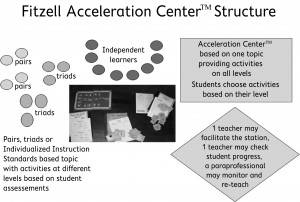While using station teaching or acceleration centers as an approach to co-teaching is often  very successful for both teachers and students, it is important to use this approach correctly. Fitzell Acceleration Centers™ are a unique twist to the old-style learning centers designed by Susan Fitzell to zero in on specific student deficits.
very successful for both teachers and students, it is important to use this approach correctly. Fitzell Acceleration Centers™ are a unique twist to the old-style learning centers designed by Susan Fitzell to zero in on specific student deficits.
To help those co-teachers already using, or thinking about implementing, an acceleration center approach in their classroom, here are:
Tips for Successful Acceleration Centers
1. Reassign partners every four to five weeks.
2. Don’t change partners in response to student requests or complaints. Doing so opens up a Pandora’s box of potential problems.
3. Acceleration Center assignments must be able to be managed and completed independently. If students cannot manage the assignments by themselves they will often stop completely or interrupt the teachers and/or other small groups for help. The goal of the center is for students to be able to increase achievement but also for teachers to gain valuable conferencing time or small group work time uninterrupted. Teachers must be able to optimize Acceleration Center time.
4. Acceleration Centers are not thematic nor do they become obsolete at any point during the school year. Avoid any seasonal connotation. They are set up for sustainability, requiring minimal prep work when prep for the centers is viewed in light of creating lesson plans suitable for an entire school year.
5. Use Acceleration Centers to support state standards or curriculum goals from basic to proficient.
6. Create procedures and rules for utilizing the Acceleration Centers with students as part of the process. By doing so, teachers engage students in the process they are more likely to buy into.
7. If setting up more than one center, start with the first one and practice the rules and procedures using the first one as a teaching tool.
8. As silly as it may sound to a secondary teacher, whether middle school, junior high, or high school, it is imperative to have students practice moving from their seats to the Acceleration Center to choose an activity and back to their seats or small groups until they can do it quietly and efficiently. This typically will take 10 or 15 minutes of practice, set up as a timed contest. Use a stopwatch and practice until students can run the procedure in three minutes or less. It may be beneficial to incorporate a reward system to maintain proper behavior and efficiency over the course of the school year.
9. Keep records of completed assignments and how those assignments align to state standards or curriculum goals.
10. Train one or two “student experts” on how the Acceleration Centers function. They do not need to know how to do the academic portion of the center; rather, they need to teach other students how to follow the instructions in the folders, how to keep the center organized, and how to explain the logistics of the center to other students. The “student expert” makes it possible for students to work without interrupting the teacher while the teacher is coaching others.

Bring Susan to your campus!
Featured seminar – Differentiation Strategies to Reach ALL Learners in the Inclusive Classroom
